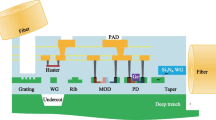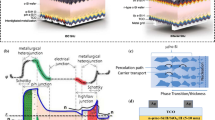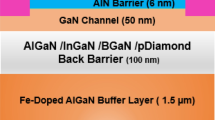Abstract
A modified quantum drift-diffusion (QDD) model is developed for non-linear analysis of SiC (4H, 6H and 3C polytypes) pin semiconductor diodes at W-band frequency regime. Effects of incorporation of a buffer layer (n-type), in between substrate and low doped active region of the hexagonal (4H and 6H) pin (p++-p+-n−-n-n++) vertical mesa structure is thoroughly studied in this paper for the improvement of MM-wave performance of the single device. Also, a thin layer of Ge has been introduced in between Si substrate and n+ cubic-SiC layer in 3C-SiC pin-device for minimising the lattice mismatch issue in between Si/3C-SiC interface. The comprehensive analysis establish that the forward characteristics, reverse recovery time (1 ns) and breakdown voltage (171 Volt) in case of 4H-SiC device are quite good in comparison to its cubic (3C) and other hexagonal (6H) counterparts, however, the switching characteristics of 3C-SiC pin diode array is comparatively better than its hexagonal counterparts. This observation could be explained in terms of lowest series resistance in 3C-SiC based single pin device that has been achieved by incorporating Ge layer in mesa structure. The authors have made a comparative analysis among SPST, SPDT and SPMT pin switches made up with 4H, 6H and 3C-SiC poly-types. At 94 GHz, W-band central frequency, series resistance in 4H-SiC single device is 0.59 Ω, whereas, the same is much lower (0.27 Ω) in case of 3C-SiC. Insertion loss and isolation in 3C-SiC pin array of switches are found to be 0.18 dB and 38 dB (SPST switch), 0.19 dB and 67 dB (SPDT switch), 0.20 dB and 90 dB (SPMT shunt type switching array) and 0.23 dB and 74 dB (SPMT series-shunt type switching array). This newly proposed QDD model validation is done through comparative studies between experiment and analytical results for 4H-SiC SPST switches in low-frequency Microwave region. The validated QDD model, coupled with PSpice and Comsol Multi-physics simulator, then used for designing of the W-band devices and corresponding switches. However, as far as author’s knowledge is concerned, no experiment is yet done with SiC pin diodes at W-band frequencies, in literature for comparison. From simulation point of view also such an extensive study on hexagonal and cubic SiC pin diode switches at W-band region has not yet been done by any other researcher group. This paper, for the first time, establishes the feasibility and potentiality of IV-IV group semiconductor based pin (p++-p+-n−-n-n++) switches for W-band applications. Comparative analysis also reveals that 3C-SiC based shunt type pin (p++-p+-n−-n-n++) SPMT switches are the best for MMW-communication systems. Thermal modelling of the designed devices are also compared and reported in this paper. The quasi-3D thermal analysis is done to optimize the mesa and heat-sink diameter/dimensions so as to minimize the thermal runaway issues. The results may further be used for developing low-cost and fast semiconductor switches for potential application in THz communication systems.






















Similar content being viewed by others
Abbreviations
- V:
-
Applied voltage
- I:
-
Forward bias current
- Ve(x, t):
-
Electric potential
- τ:
-
Carrier life time
- αp,n :
-
Carrier ionization rates
- Cp,n(x, t):
-
Charge carriers concentration
- µp,n :
-
Hole and electron mobility
- h:
-
Planck’s constant
- Cp :
-
Specific heat
- Z0 :
-
Characteristic impedance
- Vd :
-
Volume of the device
- QDD:
-
Quantum modified drift-diffusion
- IRM :
-
Reverse recovery current
- Pd :
-
Power dissipation
- θj :
-
Thermal impedance
- Ta :
-
Ambient temperature
- HC :
-
Heat capacity
- DUT:
-
Device under test
- σ:
-
Conductivity
- Tth :
-
Thermal time-constant
- tr :
-
Pulse time duration
- Mm :
-
Modulation index
- tp :
-
Pulse on time
- SPST:
-
Single-pole-single-throw
- Na :
-
Acceptor concentration
- Nd :
-
Donor concentration
- W:
-
i-region width
- fa :
-
Design frequency
- Lef :
-
Effective diffusion length
- Rs :
-
Series resistance
- ħ:
-
Normalized Planck’s constant
- ni :
-
Concentration of δ doped i-region
- KB :
-
Boltzmann’s constant
- Vb :
-
Breakdown voltage
- Rp,n :
-
Recombination rate of electron and hole
- m *p,n :
-
Effective mass of electron and hole
- Tj :
-
Junction temperature
- Ef(x, t):
-
Electric-field in the δ doped i-region
- Dn,p :
-
Diffusion constant of charge carriers
- Jp,n(x, t):
-
Current density of electron and hole
- Pn :
-
Normalized current density
- QTp,n(x, t):
-
Quantum potential
- Def :
-
Effective Diffusion constant
- ρ(x, t):
-
Volume charge density
- ISO:
-
Isolation
- IL:
-
Insertion loss
- SPDT:
-
Single-pole-double-throw
- SPMT:
-
Single-pole-multi-throw
References
Ancona MG (2011) Density gradient theory: a macroscopic approach to quantum confinement and tunneling in semiconductor devices. J Comput Electron 10:65–97. https://doi.org/10.1007/10825-011-0356-9
Atabaev IG, Juraev KN (2018) Research of pin based on 4H-SiC fabricated by low-temperature diffusion of boron. Adv Mater Sci Eng. https://doi.org/10.1155/2018/8797031
Bazin AE, Michaud JF et al (2010) High quality ohmic contacts on n-type 3C-SiC–SiC obtained by high and low process temperature. AIP Conf Proc 192:51–54. https://doi.org/10.1063/1.3518309
Bellantoni JV, Bartle DC, payne D, Dermott GM, Bandla S, Tayrani R, Raffaelli L (1989) Monolithic GaAs Pin diode switch circuits for high power MM-wave applications. IEEE Trans 37:2162. https://ieeexplore.ieee.org/iel1/22/1678/00044137.pdf. Accessed 20 June 2018
Bogle JJ, Hubert RJ, Boles TE (2010) A 50 Watt monolithic surface-mount series-shunt pin diode switch with integrated thermal sink. In: Proceeding of Asia-Pacific conference. https://ieeexplore.ieee.org/document/5728262/. Accessed 20 June 2018
Boles T, Brogl J, Hong D et al (2013) AlGaS anode hetero-junction pin diodes. Wiley Ps 10:786–789. https://www.macom.com/AlGaAs%20PIN%20Diode_ISCS_2012_Revised_112712. Accessed 20 June 2018
Camara N, Zekentes K et al (2006) Microwave pin diode and switches based on 4H-SiC. IEEE Electron Device Lett 27:108–110. https://ieeexplore.ieee.org/document/1580597/. Accessed 20 June 2018
Camara N, Zekentes K et al (2008) 4H-SiC pin diode grown by sublimation epitaxy in vacuum (SEV) and their application as microwave diodes. Semicond Sci Technol 23:1–9. https://www.researchgate.net/231114684_4H-SiC_pn_diodes_grown_by_Sublimation. Accessed 20 June 2018
Deng X, Bo Zhang et al (2007) Electro-thermal analytical model and simulation of the self-heating effects in multi-finger 4H-SiC power MESFETs. Semicond Sci Technol 22:1339–1343. https://doi.org/10.1088/0268-1242/22/12/018/meta
Dmitriev VD et al (1995) SiC a(3)n alloys and wide band gap Nitrides on SiC Substrates. Int Phys Conf Ser 141:497–502. http://www.shodhganga.inflibnet.ac.in/jspui/bitstream/10603/154792/24/24_appendix%205.pdf. Accessed 20 June 2018
Donga S, Teke A et al (2003) 4H-SiC photoconductivity switching devices for use in high-power applications. Appl Phys Lett 82:3107–3109. https://doi.org/10.1063/1.1571667
Eisele H, Haddad GI (1997) Microwave semiconductor device physics. In: Sze SM (ed) Wiley, New York. https://pdfs.semanticscholar.org/e47e/da8cae61a2f73de6cf19268fb4583d1365a7.pd. Accessed 20 June 2018
Falco CD, Gatti E et al (2005) Quantum-corrected drift-diffusion models for transport in semiconductor device. J Comput Phys 204:533–561. https://doi.org/10.1016/j.jcp.2004.10.029
Feng ZC (2003) SiC power materials and devices. Springer, Berlin
Gated E et al (2007) An improved physics-based formulation of the microwave pin diode impedance. IEEE Microwave Wirel Compon Lett 17:211–213. https://ieeexplore.ieee.org/iel5/7260/4118197/04118204.pdf. Accessed 20 June 2018
Grov AS (1967) Physics and Technology of semiconductor device, 1st edn. Willey, New York. https://www.wiley.com/…/Physics+and+Technology+of+Semiconductor+Devices-p-97. Accessed 20 June 2018
Henfiner AR, Lai JS et al (2001) SiC power diode provide breakthrough performance for a wide range of application. IEEE Trans 16:273–278. https://ieeexplore.ieee.org/document/911152/. Accessed 20 June 2018
Iturri-Hinojosa A, Resendize LM, Torchynska TV (2010) Numerical Analysis of the performance of pin Diode microwave switches based on different semiconductor materials. Int J Pure Appl Sci 1:93-99. https://pdfs.semanticscholar.org/69f6/e307d441c2963c36749d6c532ac797e11fa5.pdf. Accessed 20 June 2018
Jaingmi F, Huajun S et al (2011) Characteristics and analysis of 4H-SiC pin diodes with a carbon-implanted drift layer. J Semicond 37:(044009)4-5. https://doi.org/10.1088/1674-4926/37/4/044009/metapp-(044009)4-5
Kundu A, Kanjilal M, Das A, kundu J, Mukherjee M (2013a) Cubic structure Si Pin diode as RF switch. In: International conference IET”, pp- 119–121. https://ieeexplore.ieee.org/document/6950916/. Accessed 20 June 2018
Kundu A, Kanjilal M, Mukherjee, Ghosh D (2013b) Switching characteristics of pin diode using different semiconductor materials. Int J Adv Technol Eng Res (IJATER) 3:19–22. https://www.yumpu.com/en/document/view/49442844/switching…of…ijater/4. Accessed 20 June 2018
Kundu A, Ray Kanjilal M, Mukherjee M (2013c) Insertion loss and isolation of pin switch based on SiC family. J Electron Devices 18:1568–1574. citeseerx.ist.psu.edu/viewdoc/download?doi=10.1.1.667.2419&rep=rep1
Kundu A, Kanjilal M, Biswas P (2015) Thermal modeling of III–V WBG-based pin switch. In: Computational advancement in communication circuits and systems, Chapter 45. Springer India, pp 407–403. https://www.springerprofessional.de/en/thermal-modeling-of-iii-v-wbg-based-p-i-n-switch/4658306. Accessed 20 June 2018
Kundu J, Kundu A, Kanjilal M, Mukherjee M (2016) A 2D-thermal model for estimation of heat-dissipation in SiC based pin switches used for RF communication. In: Frontiers computer, communication and electrical engineering, Book Chapter-38, Taylor & Francis Group, India, pp 183–185. https://www.researchgate.net/…/301723363_2D-thermal_model_for_estimation_of_heat. Accessed 20 June 2018
Kundu A, Kanjilal M, Mukherjee M (2018) III–V Super-lattice SPST/SPMT pin switches for THz communication: theoretical reliability and experimental feasibility studies. Microsyst Technol 18:4053–4055. https://www.springerprofessional.de/en/journal-542-onlinefirst-articles/5301722. Accessed 20 June 2018
Leenov D (1963) The silicon pin diode as a microwave rader protector at megawatt levels. IEEE Trans Electron Devices 10:53–61. https://ieeexplore.ieee.org/document/1473671. Accessed 20 June 2018
Mukherjee M (2009) Computer studies of silicon carbide, gallium nitride and indium phosphide based IMPATT devices operating in MM Wave and terahertz region and corresponding studies on the photo-sensitivity of the devices. Ph.D. thesis, Calcutta University. shodhganga.inflibnet.ac.in/jspui/bitstream/10603/154792/11/11_chapter%202.pd
Mukherjee M, Mazumder (2010) Prospect of a β-SiC based IMPATT oscillator for application in THz communication and growth of a β SiC p-n junction on a Ge modified Si(100) substrate of a realize THz IMPATTs. J Semicond 31:(124001)1–8. https://doi.org/10.1088/1674-4926/31/12/124001
Mukherjee M, Tripathy P, Pati SP (2010) Effects of mobile spacecharge on dynamic characteristics and parasitic resistance of InP terahertz IMPATT oscillator operating at elevated junction temperature. Arch Appl Sci Res 2:42–52
NSM Electronic Archive (2019) NMS electronic archive: new semiconductor materials, characteristics and properties (online). http://www.ioffe.ru/SVA/NSM/Semicond/SiC. Accessed 20 June 2018
Nesbit G, Wong D, Li D, Chen JA (1986) A W-band monolithic GaAs pin diode switch. In: IEEE MTT symposium of digest, pp 51–55. https://ieeexplore.ieee.org/document/1114478/
Ozpenici B, Tolbert LM (2003) Comparison of wide-bandgap semiconductors for power electronics application. Oak Ridge National Laboratory. https://info.ornl.gov/sites/publications/Files/Pub57423.pdf
Pezzimenti F, Corte FG et al (2008) Experimental characterization and numerical analysis of the 4H-SiC pin diodes static and transient behaviour. Microelectron J 39:1594–1599. https://dl.acm.org/citation.cfm?id=1464742
Runhua H, Yonghong T et al (2016) Development of 17 KV 4H-SiC pin diode. J Semicond 37(084001):1–4. https://doi.org/10.1088/1674-4926/37/8/084001
Seymour DJ, Heston DD et al. (1988) X-band Ka band monolithic GaAs pin diode variable attenuation limiters. In: IEEE MTT-S digest, pp 255–258. http://www.ieeexplore.ieee.org/document/197310/ (X-K band)
Strollo AGM, Spirito P (1994) A New pin diode modeling approach for power electronic Pspice simulation. In: Proceedings of 25th annual IEEE power electronic Sp. conference, vol 1, pp 25–28. https://zapdf.com/a-new-pin-diode-modelling-approach-for-power-electronic-pspi.html
Stupelmann V, Filaretov G (1976) Semiconductor devices. MIR Publishers Moscow. https://www.sebopapirus.com.br/livro-V_Stupelman_G_Filaretov-S.
Sze SM (1997) VLSI technology, 2nd edn. McGraw-Hill International, New York
Sze SM (2008) Semiconductor devices: physics and technology, 2nd edn, Willey, New York. https://www.Semiconductor-Devices-Physics-Technology-S-M-Sze/dp/812651681
Takahashi K, Okamura S, Wang X et al. (2011) A capacitance compensated high isolation and low insertion loss series pin diode SPDT switch. In: Proceeding of the 41st European microwave communication. IEEE, pp 583–586. https://www.ieeexplore.ieee.org/iel5/6088932/6101646/06101964.pdf
Wang H, Zou H, Li H (2015) Electro-thermal coupled modeling of pin diode limiter used in high-power microwave effects simulation. J Electromagn Wave Appl 29:615–625. https://www.tandfonline.com/doi/abs/10.1080/09205071.2015.1011350
Zekentes K, Camara N et al. (2005) 4H-SiC pin diodes for microwave applications. In: IEEE (CAS) conference vol, 1, pp 17–25. https://ieeexplore.ieee.org/abstract/document/1558702/
Author information
Authors and Affiliations
Corresponding author
Additional information
Publisher's Note
Springer Nature remains neutral with regard to jurisdictional claims in published maps and institutional affiliations.
Rights and permissions
About this article
Cite this article
Kundu, A., Kanjilal, M.R. & Mukherjee, M. Cubic versus hexagonal SiC vertical pin SPST/SPDT/SPMT switches for MMW communication systems: a modified quantum drift-diffusion model for switching characteristics analysis. Microsyst Technol 27, 387–406 (2021). https://doi.org/10.1007/s00542-019-04445-9
Received:
Accepted:
Published:
Issue Date:
DOI: https://doi.org/10.1007/s00542-019-04445-9




